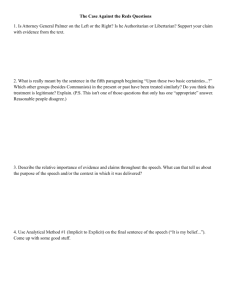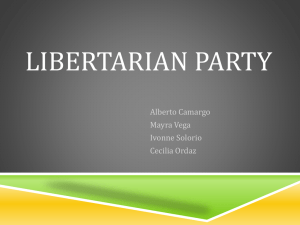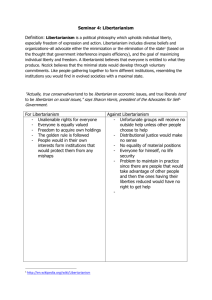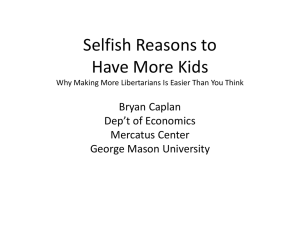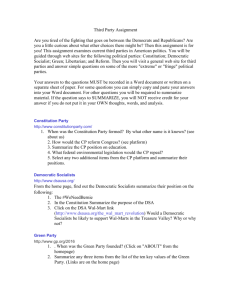Libertarianism, Feminism, and Nonviolent Action 1 Libertarianism
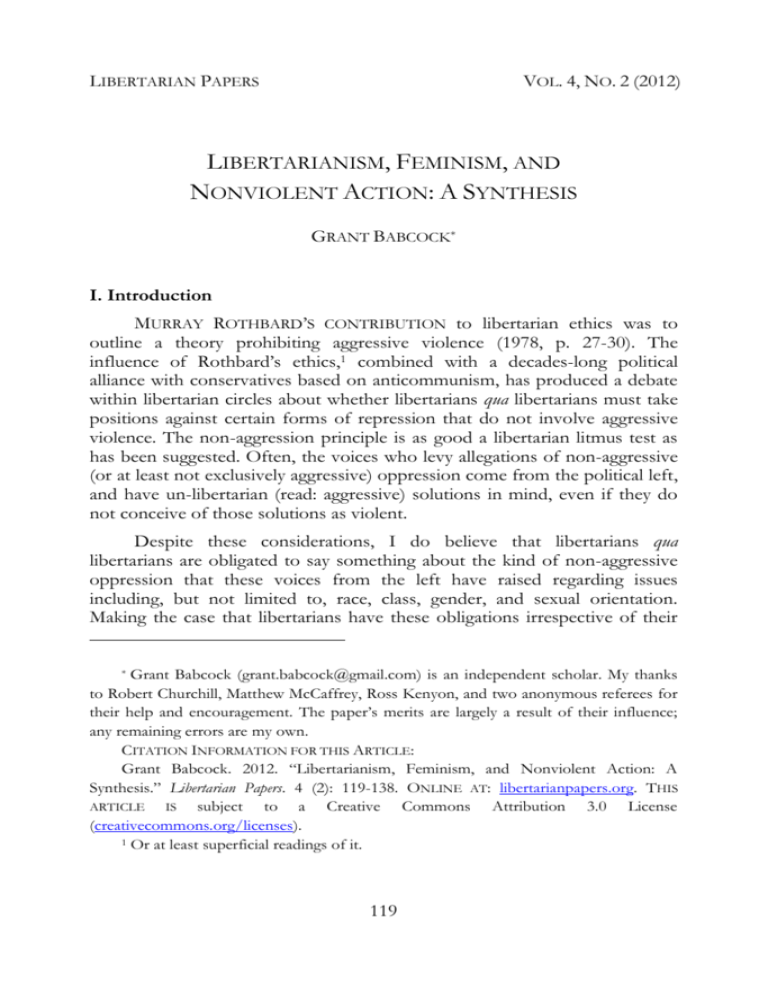
L IBERTARIAN P APERS V OL .
4, N O .
2 (2012) L
IBERTARIANISM
, F
EMINISM
,
AND
N
ONVIOLENT
A
CTION
: A S
YNTHESIS
G RANT B ABCOCK *
I. Introduction
M URRAY R OTHBARD ’ S CONTRIBUTION to libertarian ethics was to outline a theory prohibiting aggressive violence (1978, p. 27-30). The influence of Rothbard’s ethics, 1 combined with a decades-long political alliance with conservatives based on anticommunism, has produced a debate within libertarian circles about whether libertarians qua libertarians must take positions against certain forms of repression that do not involve aggressive violence. The non-aggression principle is as good a libertarian litmus test as has been suggested. Often, the voices who levy allegations of non-aggressive (or at least not exclusively aggressive) oppression come from the political left, and have un-libertarian (read: aggressive) solutions in mind, even if they do not conceive of those solutions as violent. Despite these considerations, I do believe that libertarians qua libertarians are obligated to say something about the kind of non-aggressive oppression that these voices from the left have raised regarding issues including, but not limited to, race, class, gender, and sexual orientation. Making the case that libertarians have these obligations irrespective of their * C Grant Babcock (grant.babcock@gmail.com) is an independent scholar. My thanks to Robert Churchill, Matthew McCaffrey, Ross Kenyon, and two anonymous referees for their help and encouragement. The paper’s merits are largely a result of their influence; any remaining errors are my own. ITATION I NFORMATION FOR THIS A RTICLE : Grant Babcock. 2012. “Libertarianism, Feminism, and Nonviolent Action: A Synthesis.” Libertarian Papers. 4 (2): 119-138. O NLINE AT : libertarianpapers.org
. T HIS ARTICLE IS subject to a Creative Commons Attribution 3.0 License ( creativecommons.org/licenses ). 1 Or at least superficial readings of it. 119
120 L IBERTARIAN P APERS 4 (2), (2012) libertarianism would be an easier task. Libertarianism is not, my view at least, a complete ethical system. Acts may be right or wrong for reasons outside of libertarianism; in these cases libertarianism will only come into play as offering side constraints on acceptable solutions.
2 My argument here is different: some forms of non-aggressive action are nevertheless problematic on libertarian grounds. I have in mind the type of social problems described by Roderick Long and Charles Johnson in their essay “Libertarian Feminism: Can This Marriage Be Saved?” They write: Libertarian temptations to the contrary notwithstanding, it makes no sense to regard the state as the root of all social evil, for there is at least one social evil that cannot be blamed on the state—and that is the state itself. If no social evil can arise or be sustained except by the state, how does the state arise, and how is it sustained? As libertarians from La Boétie to Rothbard have rightly insisted, since rulers are generally outnumbered by those they rule, the state itself cannot survive except through popular acceptance which the state lacks the power to compel; hence state power is always part of an interlocking system of mutually reinforcing social practices and structures, not all of which are violations of the nonaggression axiom. (Long and Johnson, 2005, §2) I shall, for the rest of this paper, take patriarchy as the model case of a repressive social relation often considered beyond the scope of the libertarian project. In doing so, I will examine those aspects of patriarchy which would not already be condemned under libertarian ethics. Libertarians need no help condemning rape, yet they often hesitate to condemn expressions of patriarchy which stop short of violence. If libertarians are serious about transforming the way humans interrelate, they must take into account more than aggression, and especially, must take into account more than aggression by the state. In doing so they must go beyond the (relatively) obvious observations that we have natural rights against both state and non-state actors, and that all individuals, male or female, possess these rights. As Long and Johnson argue, “libertarians who are serious about ending all forms of political violence need to fight, at least, a two-front war, against both statism and male supremacy” (Long and Johnson, 2005, §2). This entails condemning and combating acts which are 2 In the typology proposed by Charles Johnson (2008), my argument falls closest to “strategic thickness,” although I don’t find the descriptor “thick libertarianism” terribly helpful in understanding my argument.
L IBERTARIANISM , F EMINISM , AND N ONVIOLENT A CTION 121 not, in themselves, rights violations. It means reconciling libertarian socio political tolerance with an urgent understanding that some opinions are ethically intolerable. This makes many libertarians uncomfortable because it seems like a speedy way to end up with political commitments that are not libertarian in even the remotest sense. A large number of the proposed and/or implemented measures aimed against patriarchy are violations of libertarian ethics: affirmative action, subsidization of birth control, pornography bans, and restrictions on “hate speech” all come to mind. This much I concede. The proper response, however, is not to recoil from the necessary task of attacking patriarchy but to embrace that task with greater vigor and imagination. Methods for combating patriarchy compatible with libertarian ethics must be developed to the point that parties concerned about feminist issues cannot help but take them seriously. Steps in this direction have already been taken, although not necessarily by people working in a consciously libertarian tradition. Notable are the efforts of Gene Sharp. In The Politics of Nonviolent Action, Sharp lays out a theory of power—I will argue a libertarian theory, although he does not so identify it—upon which state power is based. He then offers an expansive typology of nonviolent methods of resistance, each category illustrated by historical examples, usually from multiple eras and places. He concludes with a description of the changes nonviolent action produces in target groups and in nonviolent actors themselves. After demonstrating Sharp’s compatibility with libertarian thinking on political power, I will examine bell hooks’s theory of patriarchy. I will show that hooks’ theory of patriarchy has many features in common with Sharp’s theory of political power. This suggests that many of Sharp’s techniques for combating political power will be applicable directly to attacking patriarchy as defined by hooks. Furthermore, one can generate additional nonviolent techniques using hooks’ theory of patriarchy in a manner analogous to the way Sharp generates techniques using his theory of political power. I will briefly discuss several nonviolent techniques for attacking patriarchy, both adapted from Sharp and generated from hooks, often with historical examples. It is my intention that the discussion be taken not as a comprehensive solution to the problem but as a proof of concept for the idea that truly serious, truly libertarian action against patriarchy is not only possible, but promising. By generating this proof of concept, I hope to offer evidence that efforts based on Sharp’s analytic framework might work against other non-aggressive forms of oppression.
122
II. Libertarian Nonviolent Action
L IBERTARIAN P APERS 4 (2), (2012) Sharp’s Theory of Power “Every ruler uses the obedience and cooperation he receives from part of the society to rule the whole…This requires and produces a hierarchical system” (Sharp, 1973, p. 24). This obedience can be secured in a variety of ways; it can also be lost. The withdrawal of obedience cripples the regime, which may attempt to respond to the withdrawal with violent repression. This repression is not guaranteed to work, as is sometimes supposed. Sharp explains that this is because repression is not an end in itself. “Punishment of one who disobeys a command,” he writes, “does not achieve the objective (for example, the ditch remains undug even if the men who refused to dig it have been shot)” (Sharp, 1973, pp. 27-28). “The answer to the problem of uncontrolled power,” Sharp concludes, “may therefore lie in learning how to carry out and maintain such withdrawal despite repression” (Sharp, 1973, p. 32). This is the theme he develops in the bulk of The Politics of Nonviolent Action. Linking the Traditions The theory of power adopted by Sharp is the same theory Long and Johnson ascribe above to “libertarians from La Boétie to Rothbard” (2005, §2). This construction suggests that Long and Johnson believe that Etienne de la Boétie is the earliest exponent of the Rothbardian strand of the libertarian tradition, a characterization I would have little quarrel with. Interestingly, Sharp identifies Boétie as also being among the first to articulate the theory of power upon which his understanding of nonviolent action is based (Sharp, 1973, p. 34). Sharp traces Boétie’s influence on later theorists of nonviolence: Boétie’s views—reputedly written at the age of eighteen—exerted a great influence upon Thoreau and Tolstoy. Through Tolstoy, those views also influenced Gandhi who saw in them a confirmation of the theory of power he had already grasped, and the political potential he had already begun to explore. (Sharp, 1973, pp. 34-35) In addition to direct citations of Boétie’s seminal essay, we can draw lines from the chain of thinkers described by Sharp above to thinkers in the libertarian tradition. For tradition (McElroy, 2002, p. 7). instance, Wendy McElroy identifies Transcendentalism, with which Thoreau is associated, as “an important vehicle for individualistic women” and places it within the libertarian
L IBERTARIANISM , F EMINISM , AND N ONVIOLENT A CTION 123 Sharp also cites the more modern political philosopher Bertrand de Jouvenel as an important theorist on the idea of withdrawal of support (Sharp, 1973, p. 35). Jouvenel influenced Rothbard as well, who quotes him in For a New Liberty on the role played by tradition and habit in securing obedience (Rothbard, 1978 p. 68) and on the perversion of “restrictive devices” into “sanctions for expanding the power of the State” (p. 80). There are a great many other points of contact between the libertarian tradition and the tradition of nonviolent action, but one of the most important might be the movement to abolish slavery in the United States. In his day, Rothbard wanted libertarianism to be committed to a platform of “abolitionism”—to the view that, whether the institution be slavery or any other aspect of statism, it should be abolished as quickly as possible, since the immediate abolition of statism, while unlikely in practice, was to be sought after as the only possible moral position. For to prefer a gradual whittling away to immediate abolition of an evil and coercive institution is to ratify and sanction such evil, and therefore to violate libertarian principles. As the great abolitionist of slavery and libertarian William Lloyd Garrison explained: “Urge immediate abolition as earnestly as we may, it will, alas! be gradual abolition in the end. We have never said that slavery would be overthrown by a single blow; that it ought to be, we shall always contend.” (Rothbard, 1978, p. 18; emphases in original) It is evident that Rothbard felt a kinship with Garrison. He believed, I think, that like Garrison his position would be vindicated by history, moving from that of an uncompromising radical to one accepted by the vast majority of right-thinking people. For his part, Sharp considers Garrison and the abolition movement an important part of the American tradition of nonviolence. He cites the example of Garrisonian actionists or Garrison himself in discussions of the sit-in (Sharp, 1973, p. 371), the ride-in (p. 376), the speak-in (p. 396), nonviolent harassment 3 (p. 369), nonviolent interjection 4 (p. 384) and selective patronage (p. 412). 3 Garrisonians would organize to “haunt” and “taunt” slave-catchers, disrupting their ability to carry out their work by making their presence public knowledge and discouraging others from abetting them (Sharp, 1973, pp. 369-70). 4 Nonviolent interjection consists of physically placing one’s self in the way of someone attempting to carry out an undesired action, with the barrier thereby established being partly physical and partly psychological (Sharp, 1973, p. 382). Garrisonians on at least one occasion rescued a man on trial as an escaped slave by hiding him in a
124 L IBERTARIAN P APERS 4 (2), (2012) It also bears mentioning that nonviolence is an appropriate method for libertarians for the simple reason that, as Sharp observes, “violent revolutions and wars have been accompanied and followed by an increase in both the absolute power of the State and in the relative centralization of power in its hands” (Sharp, 1973, p. 800). Randolph Bourne’s famous maxim, “war is the health of the state,” (Bourne, 1919, §1) is consistent with Sharp’s view. By contrast, nonviolent struggle, even for otherwise bad ends, is likely to leave society better equipped to resist the imposition of centralized control. “Whereas violent struggles tend to erode or destroy the independence of the society’s loci of power,” writes Sharp, nonviolence produces the opposite effect (Sharp, 1973, p. 804). “That increased capacity will in turn contribute to greater institutional vitality, capacity for opposing autocratic tendencies, and to the general diffusion of power in the post-struggle society” (Sharp, 1973, p. 804 5). Lest libertarians worry that Sharp’s loci are something sinister in their own right, I am happy to report that he has in mind, instead, the sort of organizations contemplated by Alexis de Tocqueville in Democracy in America (Sharp, 1973, p. 799-800). I have argued that libertarians have much in common with Sharp’s theory of political power, and that there has been significant cross-pollination between libertarian theorists and theorists of nonviolence in Sharp’s school of thought, including Sharp himself. I will now examine several more specific topics considered by Sharp. These are of special interest either because Sharp and libertarians will diverge on these points (contrary to the general trend) or because agreement of surprising types will be discovered. Strikes Sharp devotes an entire chapter to the subject of private-sector strikes. While it is certainly true that some strikes are nonviolent, it is not clear that strikers will be able to achieve their objectives merely by refusing to work. Libertarians argue that they must supplement this refusal with violence in order to have the desired leverage against their employers, except under very special conditions. “It is clear that picketing is illegitimate when it is used—as it often is—to block access to a private building or factory, or when pickets threaten violence against those who cross the picket line” (Rothbard, 1978, p. 118). The great irony of the strike is that while the target of the action is boisterous but unarmed crowd that entered the court room, surrounded the accused, and saw him safely outside (Sharp, 1973, p. 384).
L IBERTARIANISM , F EMINISM , AND N ONVIOLENT A CTION 125 ostensibly the employer, the most frequent victims of violent repression are workers.
5 (Non-) violence and Property It is clear that Sharp views a variety of actions involving other people’s property—its temporary or permanent seizure, occupation, or destruction— as nonviolent.
6 Specifically cited are sit-ins on private property including restaurants (Sharp, 1973, p. 373) and churches (p. 379), the freezing of assets (p. 410-11), and squatting in anticipation of “land reform” (p. 405-408), among other techniques. Libertarians would not generally characterize action taken with or against property one does not own as nonviolent. Burglary, for example, is a form of violence, and subtler seizures of property or interferences with its use are not thereby any less violent. These forms of action are often specifically proscribed by libertarian ethics (Rothbard: “sit-ins are an illegitimate invasion of private property” [1978, p. 118]). There are potential exceptions to the rule, however, when it comes to “public” property or property seized by a private aggressor. In these cases, there is a libertarian argument that the action is permissible. There is some debate among libertarians about the ownership status of “public” property. Consider the following passage in which Hans-Herman Hoppe presents his position on the issue in opposition to that of Walter Block: Block’s claim is that public property “is akin to an unowned good.” In fact there exists a fundamental difference between unowned goods and public property. The latter is de facto owned by the taxpaying members of the domestic public. They have financed this property; hence, they, in accordance with the amount of taxes paid by individual members, must be regarded as its legitimate owners. (Hoppe, 2001, pp. 159-160n. 10) In my view, Block has the better claim here, although perhaps he does not go far enough. Block allows only “reasonable interference” with public 5 For a dissenting opinion, see Carson (2010). 6 The chart on page 66 of The Politics of Nonviolent Action, “Six Classes of Action in Conflicts,” notwithstanding. The chart situates “material destruction only” between “nonviolent action” and “physical violence against persons plus material destruction,” suggesting that at least certain ways of violating property rights fall outside the category “nonviolent action” as Sharp conceives it.
126 L IBERTARIAN P APERS 4 (2), (2012) property along the lines of littering and “liberating” objects from the premises, saying that homesteading the land is permissible only “in a revolutionary state of war” (Block, 1998, p. 181). Nonviolent action doesn’t fit into Block’s dichotomy where the two options are violent revolt or nothing, so it is not clear what Block would say about interfering with public property in, for lack of a better word, peacetime. Regardless, Hoppe’s argument is faulty. In paying taxes, the public have not “financed” anything; they’ve been robbed. If a person wanted to lay claim to government property as a matter of restitution, that would be one thing; but it is a far cry from Hoppe’s idea that taxpayers are like shareholders in a corporation. When taxes are paid in the form of fungible assets—i.e., in almost all cases—no taxpayer can be linked to any given piece of government property purchased with those assets. This means that should a third party arrive and “steal” government “property,” it is not possible to identify the injured party, except in the case where the government took the property through eminent domain. What can we say about a case where it is known that an object has been stolen but there is no way to determine the original owner? In the absence of what Hoppe has called “intersubjectively ascertainable borders” (Hoppe, 2010, p. 168) to separate an object from the commons, it ought to be treated as unowned or permanently abandoned, or perhaps held in trust while further evidence as to the identity of the proper owner is sought. This opens up possibilities for nonviolent action involving the good in question. It is permissible, obviously, to occupy unowned land; that the thief has taken up residence or stored personal effects there is immaterial. We can conclude that Sharp’s techniques of interference with or seizure of property can usually be used when the target is public property. They are also, as I have noted, implementable against private criminals. An example of this would be if, after being evicted from my property by travelling brigands, I returned and chained myself to a spot on the property in a place where my presence would be a nuisance to the brigands. Another might be surreptitiously placing a lock on the steering wheel of a car I suspect to be stolen because, for example, all identifying markings have been removed. I might also enter the car and refuse to leave until proof of ownership was shown. Another possible action would be to nonviolently interfere with the legitimately acquired property of someone engaged in criminal activity. An example of this sort of “property invasion” would be if I put a lock on the steering wheel of a car I knew to have been legitimately acquired by Mr.
L IBERTARIANISM , F EMINISM , AND N ONVIOLENT A CTION 127 Jones, if I had reason to believe that Mr. Jones was currently involved in a bank robbery and was planning to use the car to escape. Another would be the taking of an item valuable to Jones to hold as collateral to secure the return of an item Jones had stolen or the release of a prisoner held by Jones. Secession and Nullification One might be surprised to find a discussion of secession and nullification in a work like Sharp’s, when these tactics have to some extent gained a reputation as being instruments of tyranny and relegated to the musings of the lunatic fringe. But Sharp does discuss them, and presents the ideas in a manner that is balanced, insightful, and in line with libertarian thinking. Sharp discusses nonviolent action by means of “noncooperation by constituent governmental units” in cases where there is widespread opposition to the central government, and local government is responsive to this opposition (Sharp, 1973, p. 337). As part of his explorations, he explicitly and approvingly contemplates nullification as outlined in Jefferson and Madison’s Virginia and Kentucky Resolutions as a potential means of nonviolent action (Sharp, 1973, p. 338). The rehabilitation of nullification as a legitimate means of resistance to tyranny has long been a project in which libertarian scholars have taken interest. The technique has developed an unsavory reputation which is largely underserved. Thomas Woods is an example of a libertarian historian who has attempted a rehabilitation of nullification, arguing that “The Principles of ’98 had exactly nothing to do with slavery” (2010, p. 58). Looking at the history of nullification and interposition by the States, Woods observes that “it was the northern states, and not the southern, that had more frequent recourse to these Jeffersonian principles” (2010, p. 60). Why should the appeal to states’ rights by the Confederates weigh more heavily that the history of the idea leading up to the Civil War? Woods points out that northern abolitionists were known to refer to Calhoun’s principles themselves, even citing him by name, in support of their own struggles against the fugitive slave laws. Someone evidently forgot to tell them that they were not allowed to read or cite the wicked
128 L IBERTARIAN P APERS 4 (2), (2012) Calhoun, or that these ideas were all about protecting slavery. (Woods, 2010, p. 75) Even if this were not the case, Sharp is careful throughout his book to make it clear that techniques of nonviolent action can be and have been employed to advance bad causes, such as an instance in which the segregationist proprietor of a café used the technique of “nonviolent interjection” in the summer of 1964 to prevent “a Negro couple and their son” from entering the premises (1973, p. 384). There are, however, limits to what sorts of institutions can be defended, practically, using nonviolent techniques. Sharp calls a nonviolent defense of slavery “impossible” (Sharp, 1973, p. 339). This makes sense as slavery is an ongoing act of violence against its victims, and violence is often employed to induce slaves to comply with the wishes of their purported “owners.” At first it may seem odd that even secession is advocated by Sharp as one potential technique of nonviolent action, but it should come as no surprise. One way of characterizing the libertarian-anarchist view of a just society is to say that it extends a right of secession down to the individual level. Sharp’s project of withdrawing support from tyrannical regimes might also be characterized as secessionist, if not to the same degree. In the discussion of noncooperation by constituent governmental units, Sharp indicates that the doctrine of nullification could be extended to encompass actual secession, saying of the American experience that “By itself secession was not an act of war; it only became so when military clashes occurred between Union troops and secessionist soldiers” (Sharp, 1973, p. 339). Under different circumstances, argues Sharp, we have reason to believe secession could have been a highly effective strategy for the Confederates in that conflict. Had slavery—an institution impossible to defend by nonviolent means—not existed in the South and had the South wished to secede on other grounds, it is theoretically possible that it might have done so and applied a widespread program of nonviolent noncooperation which would have been, given a very different type of society in the South, very difficult indeed for Federal forces to crush. (Sharp, 1973, p. 339) This is basically the libertarian understanding of secession as well—that as wrong as the secessionists like Calhoun were on the slavery issue, some had important insights in the realm of political theory. A system where the federal government was the arbiter of its own powers would lead to a situation of increasing federal supremacy.
L IBERTARIANISM , F EMINISM , AND N ONVIOLENT A CTION 129
III. Libertarian Feminism
If the characteristic enemy of the libertarian is the statist, the characteristic enemy of the feminist is the patriarch. In her book The Will to Change, bell hooks offers the following definition of patriarchy: Patriarchy is a political-social system that insists that males are inherently dominating, superior to everything and everyone deemed weak, especially females, and endowed with the right to dominate and rule over the weak and to maintain that dominance through various forms of psychological terrorism and violence. (hooks, 2004, p. 18) She later calls patriarchy a “system of institutionalized gender roles” (hooks, 2004, p. 25). However, hooks sees patriarchy as part of a complex of social dysfunctions linked, historical-materialistically, to capitalism: “I often use the phrase ‘imperialist white-supremacist capitalist patriarchy’ to describe the interlocking political systems that are the foundation of our nation’s politics” (hooks, 2004, p. 17). Our society is certainly imperialist. White people certainly enjoy advantages not afforded to other races, even if very few people would publicly attest to believing that the white race is superior to all others. The means of production are to some extent privately held. And our society is, lastly, patriarchal. The mistake in hooks’ description is not to be found in any of the claims considered separately, but rather in the implied claim that each characteristic entails the other so as to make the description several times redundant. I want to focus on the alleged link between capitalism and the other three descriptors. If such a link exists, there will be little hope of coherently describing a libertarian approach to feminism. However, when hooks uses the word “capitalism,” she has in mind a very different system than would many libertarian thinkers. In a conventional Marxist understanding, the economic system as it exists is capitalism more or less fully realized—it begins, on one end of the spectrum, as a liberal political system that nevertheless serves bourgeois interests, and culminates in fascism. For the libertarian, the economic system as it exists is capitalist, but not in anything like a fully realized form. We have a mixed economy, and libertarians tend to frame undesirable aspects of the current system as stemming from the ways in which the economy is socialistic or fascistic capitalism rather than capitalism proper. Offering a defense of the libertarian position on capitalism as it exists in the world today would be beyond the scope of this paper. I bring it up because it is relevant to the discussion of libertarian strategies for fighting patriarchy. If it were the case that libertarian capitalism entailed patriarchy, or
130 L IBERTARIAN P APERS 4 (2), (2012) that libertarians were apologists for the status quo rather than advocates of profound changes to the social fabric, the idea of a libertarian attack on patriarchy would be an absurdity. If it turns out, on the other hand, that patriarchy and statism share large commonalities, and libertarians have insightful things to say about statism, then libertarianism and feminism, properly conceived, might substantively overlap in important ways, and thinking from each tradition could positively inform the other. Libertarianism, for example, may be able to highlight aspects of the mainline feminist project which are self-defeating because they are statist and therefore patriarchal, and suggest alternative strategies and lenses for approaching the aspects of patriarchy in question. Feminism, with its focus on expressions of violent domination in the private, rather than public, sphere, may be able to ameliorate blind spots in the libertarian program. In doing so it may also shed some light on the “interlocking system of mutually reinforcing social practices and structures” Long and Johnson argue sustains popular obedience to the state (2005, §2). There is, in fact, a tradition of libertarian feminism, distinguished by an individualist (i.e. not collectivist or communitarian) orientation and grounded in Enlightenment political theory, especially Lockean natural law and Mill’s rule utilitarianism, which very much resembles it. The most obvious place to begin tracing this line of thought is with Mill himself, who claims a place in the libertarian tradition with On Liberty, and in the feminist tradition with his essay “The Subjection of Women.” Wendy McElroy argues that the American feminist movement was born, “ideologically and in a practical sense,” in the abolition movement that coalesced around William Lloyd Garrison (2002, p. 6). McElroy counts the Grimké sisters, Angelina Emily and Sarah Moore, as exponents of the libertarian feminist tradition from this era (2002, p. 6). At the 1848 Seneca Falls Convention, the abolitionist era Women’s movement split into a political camp, driving toward suffrage, and an anti-political camp, “influenced by Quakerism and the anarchistic philosophy of Garrison” (McElroy, 2002, p. 8). The suffrage resolution was the only resolution at the convention that did not receive a unanimous vote; it passed narrowly and over the objections, notably, of Lucretia Mott (McElroy, 2002, p. 8). McElroy writes that the anti-political faction began expressing itself in periodicals focused on “free love, free thought, and individualist anarchism,” of which the free love periodicals were the most historically important (2002, p. 8). The most notable of the free love periodicals was Lucifer the Light Bearer, a prominent victim of the infamous Comstock Act obscenity law (McElroy, 2002, p. 8). This union of free love and capitalism was no accident. Hal Sears
L IBERTARIANISM , F EMINISM , AND N ONVIOLENT A CTION 131 explains: “The doctrine of free love was bound to develop as an ethical counterpart of laissez-faire economics; both are anarchism; both were stimulated by the spacious freedom of the new world” (qtd. in McElroy, 2002, p. 8). After the assassination of President McKinley at the beginning of the 20 th century, the individualist feminist tradition was largely submerged for several decades (McElroy, 2002, p. 10). When it reemerged, the most profound break with the abolitionist radicals was on economics; the 19 th century anarchists had largely ascribed to the labor theory of value, whereas the new exponents of the libertarian feminist tradition held more modern economic views (McElroy, 2002, p. 10). There have been holdouts on this count; some modern “left-libertarians” who strongly identify with the 19 th century American individualist anarchists like Benjamin Tucker still believe in some version of the labor theory of value. A notable example is Kevin Carson (2004, pp. 13-112). The first indication of a libertarian feminist resurgence is found in Suzanne La Follette’s 1926 publication of Concerning Women (McElroy, 2002, p. 11). La Follette was mentored by Albert Jay Nock (McElroy, 2002, p. 11), whose thinking would later have a profound influence on Murray Rothbard. Then in the 1930s and 40s we see the emergence of two of the so-called “founding mothers” of modern American libertarianism: Isabel Paterson and Rose Wilder Lane, both of whom McElroy claims for the libertarian feminist tradition (pp. 11-12). The case of the third founding mother, Ayn Rand, is muddier. Long and Johnson, for example, describe Rand’s The Fountainhead as “a deeply problematic novel from a feminist standpoint” (2005, §2). McElroy concedes that Rand herself disavowed the feminist label, but argues that Rand “ushered in a revival” in individualist feminism and points out that feminist rehabilitations of Rand have been attempted by modern libertarian feminists (McElroy, 2002, p. 13).
7 To pick up where McElroy leaves off, we might take note of Tonie Nathan, who in 1972 became the first woman to receive an electoral vote in a Presidential election as the Libertarian Party’s nominee for Vice President (“Our History”). She went on to found the Association of Libertarian Feminists in 1973 (“About ALF”). Nathan writes of a worry “that many women were seeking a political system that could guarantee their complete economic security,” and that such a system would become “a husband-father 7 For a deeper discussion of Rand’s relation to feminism, see Gladstein and Sciabarra (1999).
132 L IBERTARIAN P APERS 4 (2), (2012) substitute” (“About ALF”). The state, argues the libertarian feminist, is just another patriarch.
IV. State Power and Male Power
Sharp’s anti-tyrannical program is based on an understanding of the sources of state power. A similar anti-patriarchal program would have to be based on an understanding of the sources of male power. Where does patriarchy come from, we must ask, and how is it sustained? John Bradshaw writes that “patriarchal rules still govern most of the world’s religious, school systems, and family systems” and that among the worst of these are “blind obedience—the foundation on which patriarchy stands; the repression of all emotions except fear; the destruction of individual willpower; and the repression of thinking whenever it departs from the authority figure’s way of thinking” (qtd. in hooks, 2004, p. 22). To this, hooks herself adds the following instruction: “Listen to the voices of wounded grown children raised in patriarchal homes and you will hear different versions with the same underlying theme, the use of violence to reinforce our indoctrination and acceptance of patriarchy” (hooks, 2004, p. 21). Although important, hooks stresses that the use of violence is much less common than a practice of socializing young men through rejection and shaming. “Most patriarchal fathers in our nation do not use physical violence to keep their sons in check; they use various techniques of psychological terrorism, the primary one being the practice of shaming” (hooks, 2004, p. 47). A theory of patriarchy begins to emerge. Patriarchal gender roles are learned when we are children and continually reinforced as we grow. Failure to conform to them is met with emotional abuse, or, as a final resort, physical violence, first at the hands of our parents and, later, also our peer group. Libertarians will recognize many parallels between this process and the way in which people are socialized into viewing their obedience to a government as an integral part of their identity. “Those who seek to withhold consent from their country’s governmental apparatus altogether,” write Long and Johnson, “get asked the same question that battered women get asked: ‘If you don’t like it, why don’t you leave?’” (Long and Johnson, 2005, §2). It is sometimes argued that the (patriarchal) state is necessary to prevent widespread bloodshed, but “the patriarchal methods of organizing nations, especially the insistence on violence as a means of social control, [have] actually led to the slaughter of millions of people on the planet” (hooks, 2004, pp. 29-30). Some of the more radical non-libertarian feminists have identified the state as a patriarchal
L IBERTARIANISM , F EMINISM , AND N ONVIOLENT A CTION 133 institution. Catharine MacKinnon, for example, has said that “the state is male in the feminist sense” (qtd. in Long and Johnson, 2005, §2). Because radical feminists are more likely than “mainstream” or “liberal” feminists to recognize that the state is a problematic institution, Long and Johnson argue that “the 19 th century libertarian feminists, and the 21 st century libertarian feminists that learn from their example, may find themselves far closer to Second Wave radical feminism than to liberalism” (2005, §7). Despite their suspicion of the state, however, “radical” feminists have nevertheless sometimes advocated its use in fighting patriarchy, a process libertarians understand to be akin to attempting to “douse a fire with kerosene” (Long and Johnson, 2005, §3) or to “donning the ring of Sauron” (2005, §7). A better analogy than either might be the legend of the “monkey’s paw,” a magical artifact that grants wishes but perverts them in the process, often leading to the ruin of the one who made the wish. Long and Johnson explain that non-libertarian feminists may be tempted to use the state because of the plausible view that “if state neutrality is a myth, if the state is by nature a tool in the struggle between sexes or classes or both, then it can seem as though the only sensible response is to employ it as just that” (Long and Johnson, 2005, §7). The challenge for libertarians, then, is to get feminists realize the full reasons for and implications of MacKinnon’s assertion that “powerlessness is a problem but redistribution of power as currently defined is not its ultimate solution” (qtd. in Long and Johnson, 2005, §3). Feminists must help libertarians fully understand and articulate the interlocking systems which maintain state and male power as they exist in the world. Given the relationship between state and male power and the ethical constraints on libertarian confrontation of each, both libertarians and feminists have reasons to favor a “privatized” approach of nonviolent action in combating patriarchy.
V. A Program of Nonviolent Social Change
Many of the techniques suited to nonviolent action against government oppression can be brought to bear, in unmodified or adapted form, in struggles against non-government but still patriarchal oppression. One technique that can be applied fairly straightforwardly is what Sharp labels “establishing new social patterns” (Sharp, 1973, p. 390). The following example is illustrative:
134 L IBERTARIAN P APERS 4 (2), (2012) After a meeting the Boston physician Dr. Henry Bowditch invited Frederick Douglass to walk home down Washington Street with him to dinner; Dr. Bowditch was afraid he would encounter his friends but Douglass later said that it was the first time a white had treated him as a man. In 1849 Douglass wrote in his periodical, North Star, that the way for abolitionists to remove prejudice was “to act as though it didn’t exist, and to associate with their fellow creatures irrespective of all complexional differences. We have marked out this path for ourselves, and we mean to pursue it at all hazards.” (Sharp, 1973, p. 391) “Relate to others in non-patriarchal ways” may seem obvious to the point of vapidity, but the case that it works is rather strong. The idea that “everyone conforms” can be a powerful psychological factor causing conformity to patriarchal gender roles. When attempts to raise boys free from patriarchal influence are stymied by the boys’ sexist peer groups, bell hooks has advocated a strategy of exposing the peer group to non-conforming adult male role models. She cites once example where a son of her friend wanted to wear nail polish, but met resistance from the boys at school. In response “His mother and sister gathered all the ‘cool’ adult guys [they knew] to come to school and show that males can use nail polish” (hooks, 2004, p. 40). The converse of modeling new, better modes of interpersonal conduct would be the deliberate, public breaking of patriarchal taboos, not because inversion of the taboo is desired as the new model behavior but to rob the taboo of its moral force. The practice is analogous to the breaking of unjust laws in the practice of civil disobedience. In 2011, marches called “SlutWalks” were organized as a response to victim-blaming in cases of sexual assault (Contreras, 2011). Participants in the marches were encouraged to dress “provocatively” in defiance of the norm implicit in victim-blaming that women must meet certain standards of chastity if they wish to avoid sexual assault and that they deserve protection from sexual violence only if they comply. In addition to being a form of “civil disobedience,” the SlutWalks combined elements of two other types of nonviolent action examined by Sharp, “parades” (1973, p. 154) and “protest disrobing” (p. 140). One method that might be used as a means of fighting marital rape and date rape and as a means of delegitimizing the idea of “marital rights” to sex on demand is “Lysistratic nonaction,” a form of “selective social boycott” made famous by the Aristophanes play from which it takes its name (Sharp, 1973, p. 191). Sharp notes several historical examples, so although rare, the method is not exclusively fictional. More conventional means of nonviolent action contemplated by Sharp that have been used in the past to fight
L IBERTARIANISM , F EMINISM , AND N ONVIOLENT A CTION 135 patriarchy are silence, social boycott of sexist individuals, and consumer boycott of sexist businesses. In addition to the efficacy of these methods in producing change in its targets, participation in nonviolent action can help to “deprogram” patriarchal behavior in the actionists themselves. There are deep connections between patriarchy, statism, and violence in interpersonal relationships, so learning alternative, non-patriarchal techniques of conflict can have a profound effect on all involved. Participating in nonviolence can help to ameliorate the submissiveness that patriarchy expects of, and instills in, women. “Participation in nonviolent action both requires and produces certain changes in the previous pattern of submissiveness within the grievance group,” writes Sharp (1973, p. 778), later adding: As long as members of the subordinate group regard themselves as inferiors, are submissive, and behave in a deferential and humiliating manner to members of the dominant group, repeating the customary habits of acknowledging inferiority (the lowered eyes, and ‘Yes, sir,’ for example), they confirm the dominant group’s view of them as inferiors and as creatures or persons outside the ‘common moral order.’ Submissive behavior by the subordinates helps to support the views which serve to ‘justify’ the established system. Also, such a pattern of submission makes possible the system’s continuation, for that behavior helps the system to operate smoothly.” (Sharp, 1973, pp. 778-779) By behaving in ways that run contrary to their proscribed gender role, women participating in nonviolence undermine the patriarchal system and, thereby, its ability to confine their behavior. Likewise, participation in nonviolence can transform the idea of what it is to be “manly” in ways that do not perpetuate patriarchy. One of the challenges faced by organizers of nonviolence is that “a pressure against nonviolence may arise...from the widely accepted view that violence is the only suitable response in severe conflicts, or from such a question as ‘Am I a sissy?’” (Sharp, 1973, p. 793). This last question helps explain the link between statist idea that only government responses are “serious” solutions to a problem and the patriarchal idea that violence is a “manly” response to interpersonal conflict. There is a link between how people are socialized to condone and conduct “private” violence how they are socialized to condone and conduct war. Participation in nonviolence exposes both internalized norms to a powerful challenge: “by testing out a new way of behaving, the actionist learns that his earlier fears about the consequences of nonviolent
136 L IBERTARIAN P APERS 4 (2), (2012) behavior may not in fact materialize” (Sharp, 1973, p. 792). Sharp points out that this effect can snowball from one area of a person’s social life to another. “Participation in nonviolent action, under some circumstances at least, may contribute to an extension of the areas of life in which the person may feel able to act nonviolently, instead of violently, and to an increased sympathy for nonviolence as an overall moral principle” (Sharp, 1973, pp. 791-792). I noted above that nonviolent action can have the effect of inoculating a society against the imposition of centralized control by strengthening power centers outside the state hierarchy and giving them practice in the techniques of resistance to authority, even when the nonviolent action undertaken is aimed at an otherwise bad end. Similarly, a society’s dominant conception of manliness can be transformed when members participate in nonviolent action, regardless of the intended end of that action. What is the result of such a transformation? “Rather than defining strength as ‘power over,’ feminist masculinity defines strength as one’s capacity to be responsible for self and others” (hooks, 2004, p. 117). In discussing what this responsibility entails, hooks references Nathaniel Brandon (no stranger to libertarians), who “equates our capacity to be responsible with our capacity to experience joy, to be personally empowered” (hooks, 2004, pp. 164-165). Brandon writes, “I am responsible for accepting or choosing the values by which I live…it is taking responsibility that sets me free” (qtd. in hooks, 2004, p. 165). As men participate in nonviolent resistance, they are learning to consciously step outside the dominator model proscribed for them in a way that affirms their personal worth and power rather than leaving them meek and vulnerable, as they had been conditioned to expect. This has the potential not only to lead to the unconscious formation of new habits of action, but to precipitate a reevaluation of the statist and/or patriarchal values one has uncritically internalized.
VI. Conclusion
The libertarian project, narrowly construed, does not offer a complete account of ethics or of the good life; rather, it lays out a set of side constraints by which any ethical system or account of the good life must abide. In discussing social problems connected to race, class, gender, sexual orientation, and similar issues, many libertarians have terminated their analysis upon concluding that private actors who behave in sexist, racist, etc. ways ought not to be subject to sanctions such as imprisonment and fines that violate the rights of the sanctionee.
L IBERTARIANISM , F EMINISM , AND N ONVIOLENT A CTION 137 We have seen, however, that libertarians have reasons qua libertarians to be interested in these issues, and because of this have reason to be interested in the tactical application of nonviolent techniques to effect social change in the private sphere. Importantly, such techniques often satisfy libertarian ethical side constraints. Applying these techniques to “private” social problems may require an analysis of the power structure of non aggressive (or not entirely aggressive) forms of coercion, because the power structure characteristic of those problems may differ from the power structure underlying state aggression, the power structure with which libertarians are most familiar. On the other hand, sometimes there will be deep connections between state and non-state power structures, as I argue is true in the case of patriarchy. Long and Johnson conclude in their essay that “[l]ibertarian feminism…should seek to shift the radical feminist consensus away from state action as much as possible” by “urging feminists to radicalize the insights into male power and state power that they have already developed, and to expand the state-free politics that they have already put into practice” (2005, §7). It must do this in a way that does not merely subsume feminism as a subsidiary of libertarianism, but treats feminism as a complementary project. My contribution here is to suggest the use of nonviolent action in the service of these “state-free politics” as an option well suited to the task and acceptable under libertarian ethics.
References
“About ALF.” Association of Libertarian Feminists. Web. 14 May 2012.
138 L IBERTARIAN P APERS 4 (2), (2012)
Not Capitalism: Individualist Anarchism Against Bosses, Inequality, Corporate
Power, and Structural Poverty. Ed. Gary Chartier and Charles W. Johnson. London: Minor Compositions, 2011. 131-144. Long, Roderick, and Charles Johnson. “Libertarian Feminism: Can This Marriage Be Saved?” 1 May 2005. Web. 11 July 2012.
st
Century. Washington, D.C.: Regnery Publishing, Inc., 2010.
